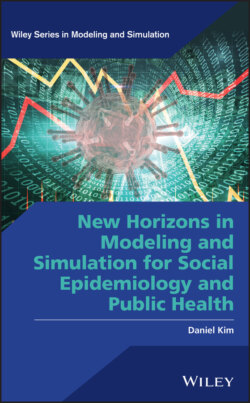Читать книгу New Horizons in Modeling and Simulation for Social Epidemiology and Public Health - Daniel Kim - Страница 7
ОглавлениеForeword
I am well acquainted with the author of this book New Horizons in Modeling and Simulation for Social Epidemiology & Public Health, Dr. Daniel Kim, and the book’s contributors including Dr. Ross Hammond. As the former director of the Systems Science Program in the Office of Behavioral and Social Sciences Research (OBSSR) of the National Institutes of Health (NIH), I have had a bird's eye view of this emerging area which I have written extensively about elsewhere (Mabry and Kaplan, 2013; Mabry et al., 2008, 2013).
The NIH and OBSSR have supported a variety of educational opportunities in systems science, such as the Symposia Series on Systems Science and Health (2007; https://www.preventionresearch.org/conferences/training/2007‐symposia‐series‐on‐systems‐science‐and‐health/) and the week‐long immersion course, Institute on Systems Science and Health ( ISSH ), which ran annually from 2009 to 2012. More recently, the NIH has funded short courses such as Dynamic Systems Science Modeling for Public Health (PIs: Bruch, Hammond, Osgood; healthmodeling.org). However, one of the noteworthy gaps in the field is adequate instructional material in book form devoted to systems science applications to public health.
In 2012, Drs. Kim and Hammond both participated (Dr. Kim as a trainee and Dr. Hammond as the lead instructor) in the agent‐based modeling (ABM) track of the week‐long ISSH training course, at Washington University in St. Louis, hosted by Drs. Peter Hovmand and Doug Luke. As a cofounder and producer of ISSH (with Dr. Bobby Milstein, then at Centers for Disease Control and Prevention [CDC]), I had the privilege to witness the germ of this book. Dr. Kim has taken the best he has to offer in the social determinants of health and microsimulation modeling, complemented it with the expertise of Dr. Hammond in ABM and of other excellent book contributors with command of their subject areas, and produced what is destined to become a key resource for public health students, professors, and practitioners. New Horizons in Modeling and Simulation for Social Epidemiology & Public Health, with its focus on agent‐based modeling, microsimulation, and social determinants of health, is the perfect complement to the recent entrants in this area (El‐Sayed and Galea, 2017; Kaplan et al., 2017) as well as Dr. Thomas Valente’s (2010) impactful Social Networks and Health.
As indicated by its title, New Horizons in Modeling and Simulation for Social Epidemiology & Public Health is designed to give graduate students in public health an introduction to modeling and simulation to address research questions in social epidemiology and public health. While this is an excellent resource for this audience, it is sure to become a staple on the bookshelf of not only students but professors in public health and many other health‐relevant disciplines. The book provides an excellent introduction to social epidemiology followed by classic case examples in ABM (Schelling model and study of the historic Anasazi population; also within the book's covers the reader will find essential background on ABM use in public health including an overview of ABM for infectious disease modeling, obesity, and tobacco control) and highlights some of the seminal contributions Dr. Hammond has made to the field. The book contains a comprehensive introduction to microsimulation including how to make informed choices regarding time and space, data, policy rules and scope, population structure, validation, and more. An application section illustrates microsimulation models used in population health. A chapter is devoted to educating the reader about various microsimulation models in the social sciences (economics, demography, geography, transportation, and environmental sciences). The book never loses its focus on the social determinants of health, and there are valuable chapters devoted to reviewing the literature on microsimulation models and social determinants of health including important recent contributions by Dr. Kim (Chapter 9), as well as the potential of microsimulation to explore other questions in this vein (Chapter 10). Finally, the book lays out a conceptual model and empirical examples of how ABM and microsimulation can be integrated for additional impact.
With so much information packed into this readable book, it will quickly become a go‐to reference and primer of choice for anyone interested in modeling for public health and/or interested in studying the social determinants of health.
Patricia L. Mabry, PhD
Research Investigator
HealthPartners Institute
Former Senior Advisor and Acting Deputy Director, National Institutes of Health (NIH) Office of Behavioral and Social Sciences Research (OBSSR)
References
1 El‐Sayed, A.M. and Galea, S. (eds.) (2017). Systems Science and Population Health. Oxford University Press.
2 Kaplan, G.A., Diez Roux, A.V., and Simon, C.P. (eds.) (2017). Growing Inequality: Bridging Complex Systems, Population Health, and Health Disparities. Washington, D.C.: Westphalia Press.
3 Mabry, P.L. and Kaplan, R.M. (2013). Systems science: a good investment for the public’s health. Health Education and Behavior 40 (1 suppl): S9–S12.
4 Mabry, P.L., Milstein, B., Abraido‐Lanza, A.F. et al. (2013). Opening a window on systems science research in health promotion and public health. Health Education and Behavior 40 (1 suppl): 5S–8S.
5 Mabry, P.L., Olster, D.H., Morgan, G.D., and Abrams, D.B. (2008). Interdisciplinarity and systems science to improve population health: a view from the NIH office of behavioral and social sciences research. American Journal of Preventive Medicine 35 (2 suppl): S211–S224.
6 Valente, T.W. (2010). Social Networks and Health: Models, Methods, and Applications, vol. 1. New York: Oxford University Press.
